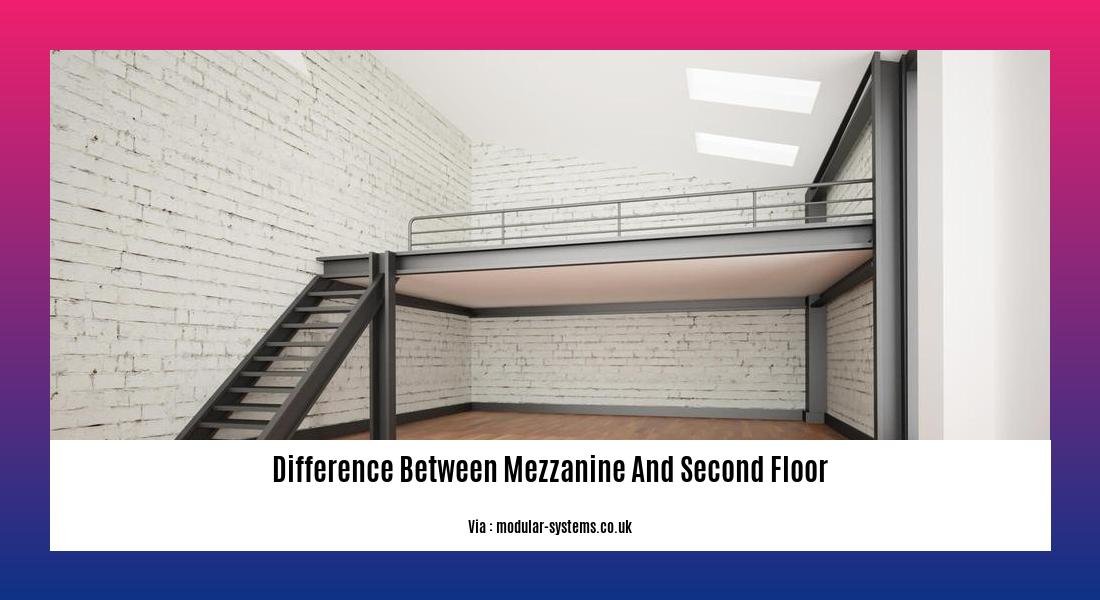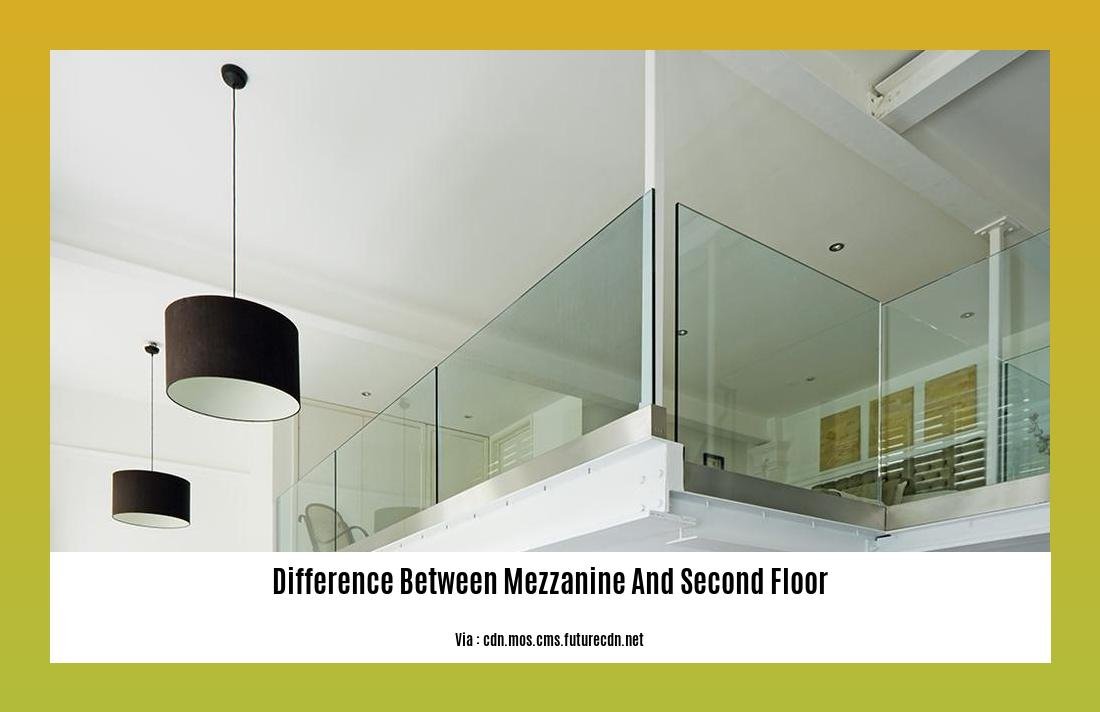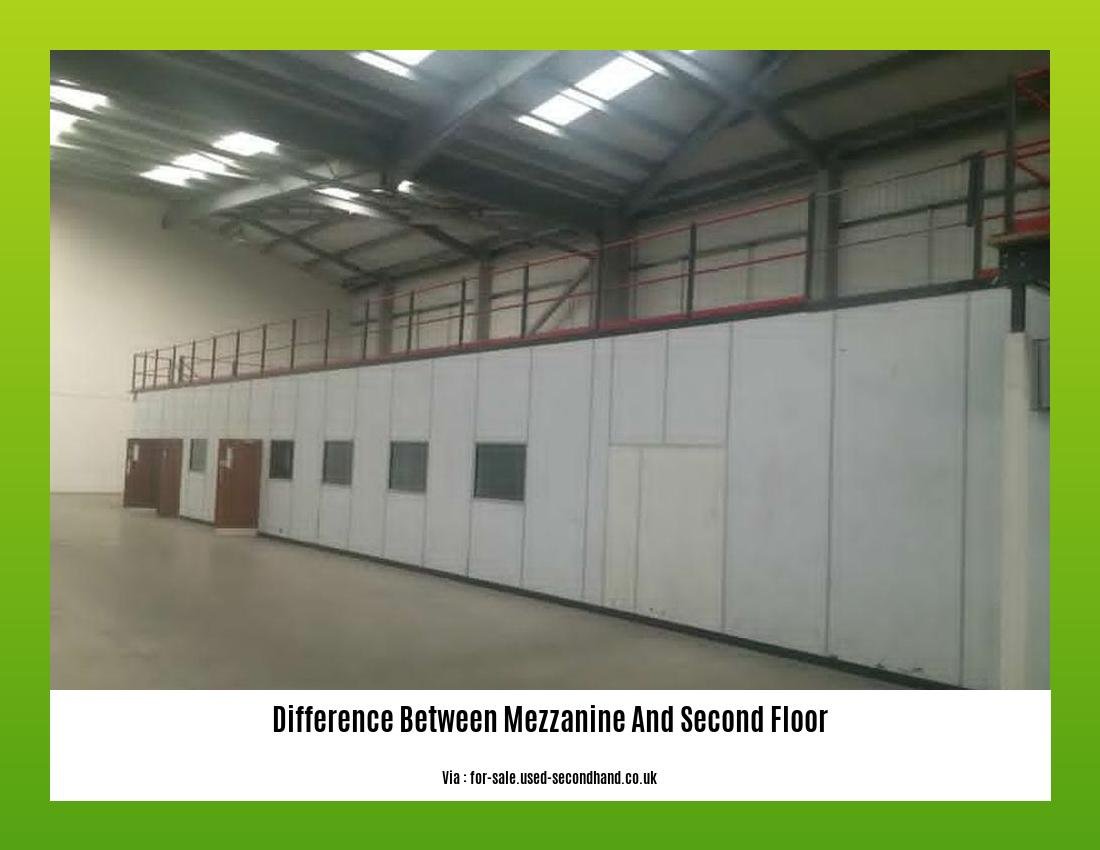Understanding the Difference Between Mezzanine and Second Floor in Architecture: Mezzanine Floor Differences and Benefits of Mezzanines and Second Floors Safety Difference Between Mezzanine And Second Floor In Construction. Delving into the world of architecture, it is essential to comprehend the nuances between a mezzanine and a second floor. While these terms may at first seem interchangeable, a closer examination reveals distinct differences that greatly impact the functionality and design of a space. In this article, we will explore the diverse characteristics of mezzanines and second floors, shedding light on their unique benefits and safety considerations in construction. Through a clear and concise analysis, readers will gain a comprehensive understanding of these architectural features and their vital role in creating exceptional spaces.
Key Takeaways:
- Mezzanines and second floors differ in their use and construction.
- Mezzanines are commonly used in industrial and commercial settings for storage, office spaces, or cleanrooms.
- Second floors are more permanent renovations that require extensive planning and structural modifications.
- Mezzanines offer quick installation, flexibility, and cost-effectiveness compared to constructing a second floor.
- Second floors provide a more permanent and independent solution for increasing floor space.
- Mezzanines are typically constructed using prefabricated steel structures or modular systems, while second floors require more extensive construction work.
- Both mezzanines and second floors need to comply with building codes and regulations for structural safety and fire protection.
- Mezzanines are generally more cost-effective than constructing a second floor.
- The decision between a mezzanine and a second floor depends on specific needs, budget, and long-term plans.
Difference Between Mezzanine and Second Floor

Mezzanines and second floors are both elevated floors, but they differ in their use and construction. Let’s explore the key differences between these two architectural features.
Mezzanine: Versatile and Cost-Effective
A mezzanine is like an interior balcony that is open to the floor area below. This feature is commonly used in warehouses, factories, offices, cleanrooms, and for storage purposes. Mezzanines are preferred in industrial and commercial settings due to their versatility and cost-effectiveness.
Benefits of Mezzanines
Mezzanines offer several advantages over constructing a second floor. First, they are quick to install, saving both time and money. Additionally, mezzanines can be easily adjusted and customized to suit specific requirements. Businesses often use mezzanines to create additional office spaces, storage areas, or cleanrooms. They can also be relocated or expanded as the business needs change.
Construction of Mezzanines
Mezzanines are typically constructed using prefabricated steel structures or modular systems. These systems are designed to be easily assembled, disassembled, and reconfigured as needed, making installation relatively quick and efficient.
Second Floor: Permanent and Independent
A second floor, on the other hand, is a more permanent renovation to a building that requires significant time, money, and resources to create. Unlike mezzanines, second floors are independent levels that are closed off from the lower floor, resembling a traditional story in a building.
Benefits of Second Floors
While second floors require more time and resources to create, they provide a more permanent and structurally independent solution for increasing floor space. Constructing a second floor can be a suitable option for businesses or building owners with long-term plans and a budget to invest in a more substantial renovation.
Construction of Second Floors
Constructing a second floor involves more complex and extensive construction work. It requires significant planning, engineering, and structural modifications to the existing building. Building permits and professional design and engineering services are typically required. The process may involve acquiring additional land or space, depending on the specific project.
Factors to Consider
When deciding between a mezzanine and a second floor, there are several factors to consider. These include the specific needs of the business or building owner, the available budget, and the long-term plans for the space.
Compliance with Building Codes
Both mezzanines and second floors must comply with relevant building codes and regulations to ensure structural safety, fire protection, and adequate access and egress. Mezzanines should be designed and installed by professionals to ensure proper load-bearing capacity and stability. Similarly, second floors should be constructed in compliance with building codes to ensure structural integrity and safety.
Cost Considerations
Mezzanines are generally more cost-effective compared to constructing a second floor. The cost of mezzanines can vary depending on factors such as size, materials, complexity of installation, and any additional features or customization required. On the other hand, constructing a second floor involves significant expenses, including construction materials, labor costs, engineering fees, and potentially acquiring additional land or space.
Making an Informed Decision
In summary, the choice between a mezzanine and a second floor depends on the specific needs, budget, and long-term plans of a business or building owner. Mezzanines offer a cost-effective and flexible solution for maximizing floor space, while second floors provide a more permanent and independent level to accommodate growing needs. Understanding the differences in use and construction can help make an informed decision when considering these options.
Sources:
[^1^]: Mezzanines Vs. Floors: What’s the Difference? by Heighton, retrieved from heighton.com.au
[^2^]: Mezzanine or Second Floor? by Kilo Lima Code, retrieved from kilolimacode.com
To find out if mezzanine counts as floor area, click here.
Curious about the thickness of a mezzanine floor? Discover the answer here.
Learn how to build a mezzanine in Sims Freeplay by following this step-by-step guide here.
Looking for information on mezzanine debt rates? Get all the details here.
Understanding the Difference Between Mezzanine and Second Floor in Architecture

Safety
When it comes to discussing the difference between a mezzanine and a second floor in architecture, it’s important to consider the aspect of safety. Both mezzanines and second floors need to comply with building codes and regulations to ensure the well-being of occupants and the structural integrity of the building.
Key Takeaways:
- Mezzanines are open intermediate floors that provide additional space and are commonly used in warehouses, factories, offices, and cleanrooms[^1^].
- Second floors, on the other hand, are more permanent renovations that require significant time, money, and resources[^1^][^2^].
- Mezzanines are versatile, cost-effective, and can be easily installed and customized to specific needs, making them ideal for businesses requiring extra space[^1^].
- Second floors offer a more permanent and independent level, providing structurally closed-off spaces that resemble traditional building stories[^1^][^2^].
- Mezzanines are typically constructed using prefabricated steel structures or modular systems, allowing for efficient installation[^1^].
- Constructing a second floor involves more extensive construction work, including structural modifications, building permits, and professional design services[^2^].
- Both mezzanines and second floors need to comply with building codes to ensure structural safety, fire protection, and proper access and egress[^2^].
- Mezzanines should be designed and installed by professionals to ensure load-bearing capacity and stability[^1^].
- Second floors require compliance with building codes to ensure structural integrity and safety[^2^].
- Mezzanines generally offer a more cost-effective solution compared to constructing a second floor[^1^].
- The cost of mezzanines can vary depending on factors such as size, materials, and complexity, while constructing a second floor involves additional expenses like labor and engineering fees[^2^].
[^1^]: Mezzanines vs. Floors: What’s the Difference? by Heighton
[^2^]: Mezzanine or Second Floor? by Kilo Lima Code
Difference Between Mezzanine And Second Floor In Construction
Mezzanines and second floors are both elevated floors that offer additional space within a building. However, they differ in their use, construction methods, and cost-effectiveness. Let’s explore the key differences between mezzanines and second floors in construction.
Mezzanines: Versatile and Cost-Effective
Mezzanines are commonly found in warehouses, factories, offices, cleanrooms, and for storage purposes. They are like interior balconies that are open to the floor area below. Mezzanines offer a cost-effective solution for maximizing floor space without the need for extensive construction or major renovations.
One of the advantages of mezzanines is their versatility. They can be easily installed and customized to suit specific requirements. Whether you need additional storage space, office areas, or cleanrooms, mezzanines can be tailored to meet your needs. Mezzanines are typically pre-drilled and can be quickly assembled by experienced installers. These structures are designed to be easily assembled, disassembled, and reconfigured as needed, making installation relatively quick and efficient.
In terms of construction, mezzanines are typically constructed using prefabricated steel structures or modular systems. These systems allow for efficient installation and can be adjusted or expanded in the future as business needs change. It’s important to note that mezzanine construction does not depend on whether the area is a balcony or a closed-in area.
Second Floors: Permanent and Independent
Unlike mezzanines, second floors are more permanent renovations that require more time, money, and resources to create. They are considered separate floors, not mezzanines. Second floors have a different roof line from the floor below and are closed off from the lower floor, resembling a traditional story in a building.
Constructing a second floor involves more complex and extensive construction work. It requires significant planning, engineering, and structural modifications to the existing building. Building permits and professional design and engineering services are typically required for second-floor construction. These structural changes, permits, and design services contribute to the higher cost of constructing a second floor compared to mezzanine installation.
Key Takeaways:
- Mezzanines are open intermediate floors used in warehouses, factories, offices, and cleanrooms, offering versatile and cost-effective space solutions.
- Second floors are more permanent renovations that require significant time, money, and resources, providing structurally closed-off spaces resembling traditional building stories.
- Mezzanines are easy to install and customize, making them ideal for business needs that may require extra storage space, office areas, or cleanrooms.
- Second floors involve complex construction work, including structural modifications, permits, and professional design and engineering services.
- Mezzanines are typically constructed using prefabricated steel structures or modular systems, allowing for quick installation and future adjustments.
- Second floors require compliance with building codes for structural integrity and safety and often involve higher expenses due to labor, engineering fees, and potential land acquisition.
Sources:
– Mezzanines Vs. Floors: What’s the Difference? by Heighton
– Mezzanine or Second Floor? by Kilo Lima Code
FAQ
Q1: What is the difference between a mezzanine and a second floor in architecture?
A1: Mezzanines and second floors differ in their use and construction. Mezzanines are open to the floor area below and are commonly used for storage, office spaces, or cleanrooms in industrial and commercial settings. Second floors are more permanent renovations that require extensive construction work and are separate levels that are closed off from the lower floor, resembling a traditional story in a building.
Q2: What are the benefits of choosing a mezzanine over a second floor?
A2: Mezzanines offer quick installation, flexibility, and cost-effectiveness compared to constructing a second floor. They can be easily customized, relocated, or expanded as business needs change. Additionally, mezzanines do not require as much time or resources as second floors.
Q3: How are mezzanines and second floors constructed?
A3: Mezzanines are typically constructed using prefabricated steel structures or modular systems, which can be easily assembled and reconfigured as needed. Second floors require more extensive construction work, including structural modifications, building permits, and professional design and engineering services.
Q4: What building codes and regulations should be followed for mezzanines and second floors?
A4: Both mezzanines and second floors need to comply with relevant building codes and regulations to ensure structural safety, fire protection, and adequate access and egress. Mezzanines should be designed and installed by professionals to ensure proper load-bearing capacity and stability. Similarly, second floors should be constructed in compliance with building codes to ensure structural integrity and safety.
Q5: How do the costs compare between mezzanines and second floors?
A5: Mezzanines are generally more cost-effective compared to constructing a second floor. The cost of mezzanines can vary depending on factors such as size, materials, complexity of installation, and any additional features or customization required. On the other hand, constructing a second floor involves significant expenses, including construction materials, labor costs, engineering fees, and potentially acquiring additional land or space.
- Does 100% Polyester Shrink? A Complete Guide to Washing & Drying - April 16, 2025
- Elegant Drapery Solutions for Arched Windows: A Complete Guide - April 16, 2025
- The Best Dining Room Tables with Drop Leaves: A Buyer’s Guide - April 16, 2025










